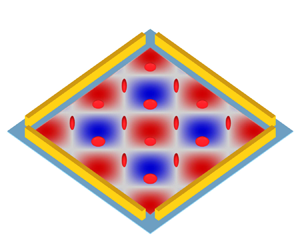No CrossRef data available.
Published online by Cambridge University Press: 11 January 2024

A computational model is developed to study the time-averaged mean dynamics of red blood cells (RBCs) driven by the time-averaged mean stress generated by two phase-shifted orthogonal ultrasonic standing waves in a viscous fluid. The cell is modelled as an ellipsoidal viscoelastic membrane enclosing the viscous fluid cytoplasm, the motion of which is described by the inclination angle of the ellipsoidal cell shape and the phase angle of the potential membrane cycle. Based on the acoustic perturbation method, the acoustic field and acoustic streaming field are solved to obtain the time-averaged mean stress, and then the temporal evolution equations of the inclination and phase angles of the cell are determined considering the torque balance and energy conservation. At a small acoustic pressure amplitude, this model reproduces the experimentally observed features of cell motion in orthogonal standing waves: the transition from steady stationary orientation to unsteady tumbling with the increase of the phase difference between the two standing waves. By turning up the acoustic pressure amplitude above a critical value, it is further predicted that the previously observed motions can be accompanied by the membrane tank-treading rotation. Observations of these motions, combined with the present computational model, can help to evaluate the mechanical properties of RBC membranes in an automated and high-throughput manner by acoustic methods.